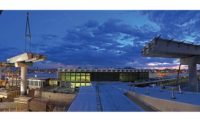 |
When the new $1.9-billion Airtrain opens Dec. 17 in New York City, it will be the first time light rail has connected Manhattanites to a New York City airport. Internmodal transportation advocates mark the opening as an example of North Americas slow but steady progress toward improving airport connectivity.
Construction of the precast segmental guideway snaking 8 miles to connecting subway stations went more smoothly that on its sister system for New Jersey Transit, a $354-million monorail to Newark Airport that required $25 million to repair shortly after it opened. But the Kennedy Airport job was delayed a year by a fatal accident during testing that killed the operator and it has come under fire for its use of airport passenger facility charges and lack of express service.
|
Still, it represents progress. "I get the impression rail connections are coming slowly in the U.S.," says Andrew Sharp, general director of the London-based International Air Rail Organisation. "A lot of the North American examples are multi-stop subways, quite a contrast to Europe and the rest of the world, where nonstop airport express service is a fact of life."
There are many proposals and some ongoing projects for improving airport intermodal connections. A design-build team led by Watsonville, Calif.-based Granite Construction is nearing completion of a 12-mile, $715-million light-rail system connecting Minneapolis with the airport. And San Francisco this year opened its 8.7-mile, $1.5-billion design-build subway extension connection.
 |
| DIRECT San Franciscos subway-airport connector will be followed by others. (Photo courtesy of HNTB) |
In Miami, foundation work is under way for a $190-million consolidated car rental facility with an automated people mover link to the terminal, says Ricardo Fernandez, Miami Intermodal Center facilities manager. A $312-million station with bus, rail and future high-speed rail links will break ground next year, he says. In Chicago, OHares $6.6-billion modernization program includes plans for a 2.5-million-sq-ft intermodal terminal that would link the airports core with a 1.5-mile people mover.
One of the most notable jobs is Dallas-Ft. Worths intra-airport automated people mover, Skylink. A $872.9-million guaranteed maximum price contract by Greeley, Co.-based Hensel-Phelps is almost complete, says Andy Bell, Skylink managing executive. The five-mile precast guideway, 50 ft high, required 30,000 night gate closures, airfield work and 300,000 sq ft of terminal renovation. And there were no serious injuries, says Perfecto Solis, DFW assistant vice president of project development.
Click below for more articles from special report "Airports of the Future">>
Introduction: Challenges in Airport Design and Construction Aren't New
Design: The Future is At the Gate
International: Global Aviation Takes Off
Security: Baggage Screening Goes In-line, Out of View
Regionals: Reviving with Revisions
Airport Products

